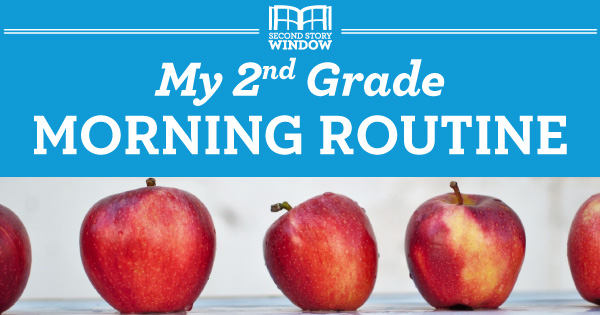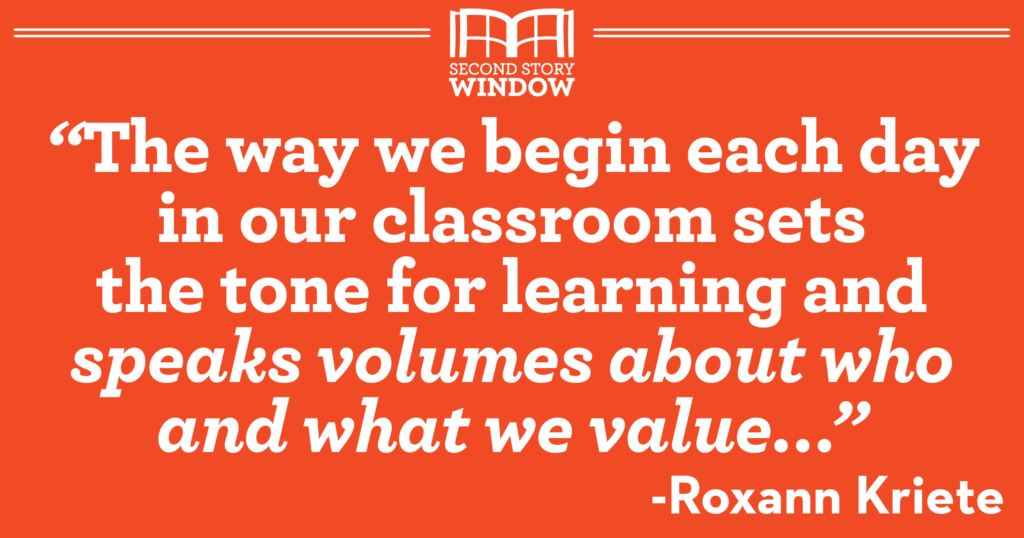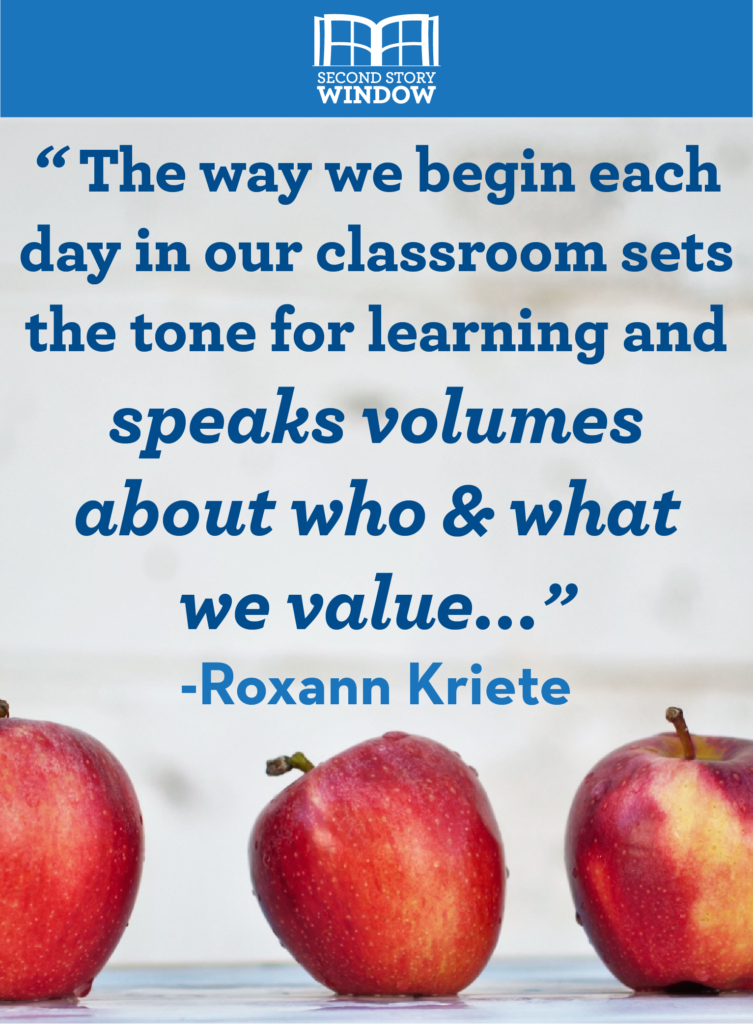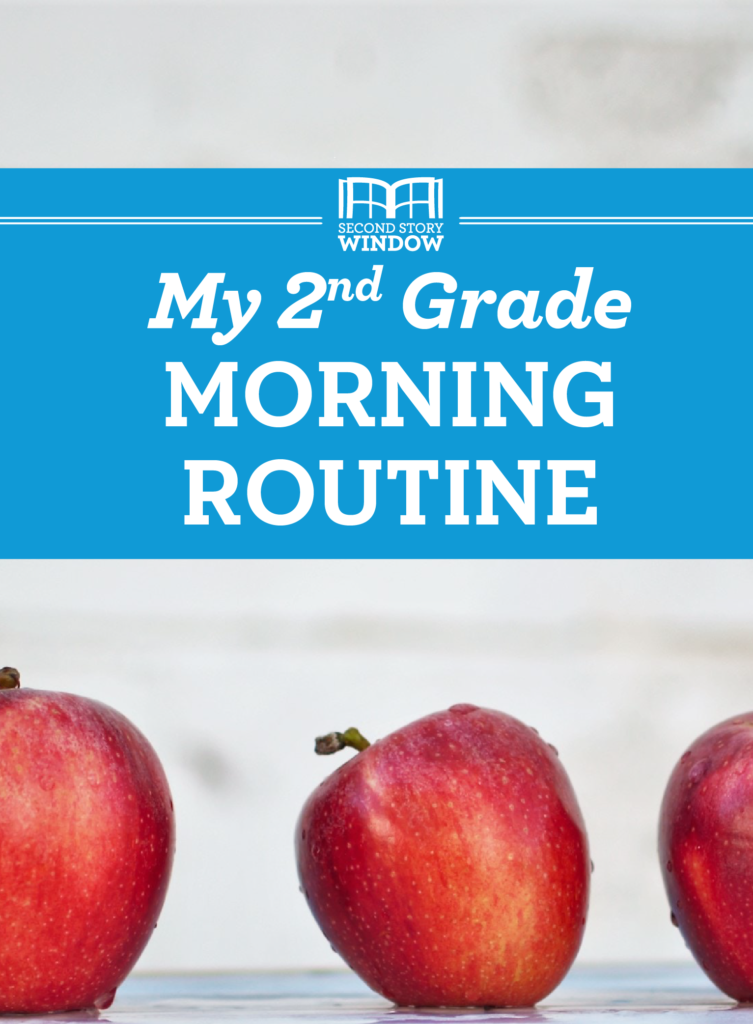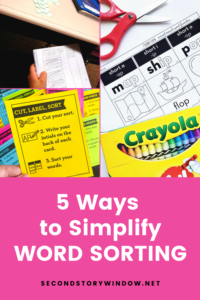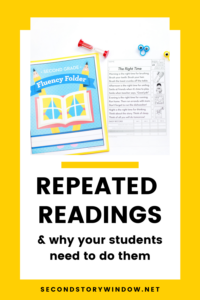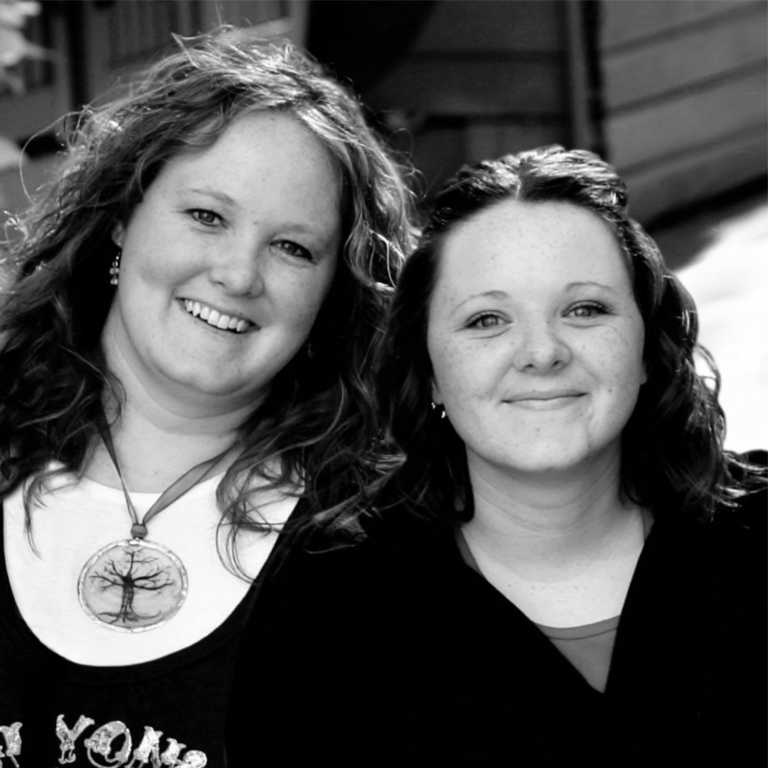The way we begin each day in our classroom sets the tone for learning and speaks volumes about what and whom we value, about our expectations for the way we will treat each other, and about the way we believe learning occurs.
–Roxann Kriete
How do you start your school day?
It’s a question every teacher has to answer. There’s a lot to consider when you think about the first 60 minutes of a school day. And there are an endless number of activities you could choose to include in your morning routine. There is no right or wrong way to start your day.
What’s actually important is to purposefully select an activity that aligns with your goals. And regardless of what you choose, keep it simple enough (routine enough) that it can be completed without active guidance from you.
In our post Morning Routines: Setting the Stage for Success, we share a step-by-step guide to help you identify goals and key areas of focus, develop a streamlined routine, and make a plan to teach your procedures. By the end, you’ll have a personalized routine for morning success! Click here to download our free Morning Routines Planning Guide and then visit the full post.
If you’re curious to see how we put all of those ideas into practice ourselves, this post is for you!
Here’s an overview of how I structured my morning routine.
Keep in mind that it takes 3-6 weeks to introduce and practice routines. What you see below is the routine we have once everything is running at peak efficiency.
- 8:35: Students are allowed in the room — They can read, play, go to breakfast, or begin morning work. Students make lunch choice as they enter using labeled clothespins on signs. This serves to mark attendance as well. Then they hang up their backpacks, and turn in their homework and reading books in bins near the coat hooks. Then they respond to the Morning Message.
- 8:50: First bell — I wait by the door to greet students. Students already in the room come over to say good morning (if they haven’t already). Students clean up their materials, unstack a chair, and get out Morning Work and pencils.
- 8:55: Late bell & announcements — After announcements and the pledge, I answer any Morning Work questions. Students work independently then choose a book to read. I enter lunch counts and attendance, answer notes, and finish preparing for the day. The class “librarian” returns the take-home books to the office.
- 9:15: Daily 5 — Students finish with Morning Work transition to their first Daily 5 Station. I don’t meet with small groups at this time so I can finish preparing for the day, glance over morning work, deal with any paperwork, work one-on-one with students (giving make-up tests, offering interventions, etc.), or finishing something that didn’t get finished the day before.
- 9:35: Correct Morning Work — Stations are cleaned up and students return to their seats to correct Morning Work. They take out a crayon and we discuss the page as a class.
- 9:40-9:55: Morning Meeting — We transition back to the rug (in a circle).Greeting, sharing, game, announcements and morning message, mindfulness, and then…
- 10:00: Lesson — We’re ready to start Writer’s Workshop!
I intentionally crafted this routine to provide the maximum amount of student independence without compromising the meaningfulness of what the students were actually doing.
In his book, The First Days of School, Harry Wong sites a study that identified 4 characteristics of productive management. All 4 components of effective management are present in our morning schedule.
- Students know what is expected of them and are generally successful doing it.
- There is relatively little wasted time, confusion, or disruption.
- Students are engaged in meaningful instructional activities.
- The climate of the classroom is work-oriented, but relaxed and pleasant.
I begin teaching our morning routine on the afternoon of the first day of school. For my sanity’s sake, I need them independent as soon as possible!
I teach the first routine I want them to complete–making a lunch choice. They had already done that when they arrived, but now I take the time to really explain and model and give them a chance to practice. As much as possible, that first day we practice how to come in and what to do after arriving.
It takes a couple weeks for them to get comfortable with our morning procedures (and I still have to remind students to do their lunch count sometimes). But since I’m aware of this, I make sure to offer the necessary supports.
First, I try to plan ahead enough so that I don’t have to worry about last minute prep in the morning. I don’t last at that all year–a lot of mornings I’m still running to the copier–but in the beginning I make an intentional effort to be present physically and mentally when students arrive.
Second, I post the list of morning steps on the board every day. The kids know they can always reference the assignment on the board. I start with the first thing (lunch choice) and end with the last (read silently). It’s listed on the board, every day, in the same place, all year long.
At the beginning of the year, I try to include pictures so low readers can use the list, too.
This way there’s never a question about what is expected. If a child asks me what to do, I direct them straight to the board. They learn very quickly that they don’t have to rely on me for answers and can solve problems themselves.
One added benefit of an efficient routine is the support it offers struggling students. Kids who need the most help thrive with predictable routines. Because they know exactly what’s expected, they have more focus to put into accomplishing academic goals.
Time and energy are finite resources. I try to make the most of both time and energy by organizing for efficiency.
I sequenced the steps for the morning routine to be as streamlined as possible. I first want students to make a lunch choice, so I put my sign-in next to the door.
Next, students hang up their backpacks and turn in their homework. The bins for returning homework and take-home books are as close to the backpacks as possible.
It’s not a perfect system. For example, the chairs had to be out of the way for the custodians, so they’re not as near the desks as I’d like. But I did my best to make tasks flow in a logical order.
I always plan for the “what’s next?” I don’t want to give my students a chance to cause problems, so I make sure there’s always something else to be done. Sometimes there’s another task waiting. Sometimes there’s an open-ended activity.
For example, after turning in homework, students get out their materials for the day. Then they have the choice of going to breakfast, playing, reading, or starting Morning Work. But once Morning Work is finished, they’re asked to read until I decide it’s time for them to be done!
I never leave the question of what to do up to the children because I will never get the response I want!
Another way to maximize every minute is to assign students jobs.
Don’t saddle yourself with tasks the kids can do! If your students can change the calendar, sharpen pencils, collect papers, return books, deliver notes…let them!
Your students might have jobs to start the day, end the day, or even in the middle of the day. The older the students, the more they can take on. If you can save yourself time and energy by outsourcing a task to your kids, do it!
Click here to download your FREE Morning Routines Planning Guide
But don’t get so lost in the to-do lists that you forget what’s most important.
Your first priority of the day is to get your students to work.
You wouldn’t keep your job long if you had to ask your principal every morning, “What should I do today?” You are expected to show up and know what to do.
Give your students the same responsibility.
They should come into class in the morning knowing:
- how to prepare for the day
- that there is a learning experience waiting for them
- where to find the details of that experience
- how to complete the experience
You might call the first task of the day Bell Work or Seat Work. We call it Morning Work.
Every day, we offer our students a page of spiral review in math and language. It takes a few days to establish the routine, but pretty soon our kids get to work without direction. This frees us up to attend to all those housekeeping tasks that have to be tackled in the morning.
What is spiral review? Spiral review means revisiting previously learned information over and over in the year.
Why do we use it?
We selected spiral review as our method of Morning Work for several reasons.
- First, it can be completed independently. If students are working with material already covered in class, they should be able to complete the assignment with minimum or no assistance.
- Second, spiral review is one of the most effective ways to transfer information from short term to long term memory. You can’t teach something in October and expect it to still be remembered in April without spiral review. There was a great piece on Nova that talks about the value of spiral review, skip to the 34 minute mark to see it.
- Third, retrieval practice is one of the most effective ways to help students maximize their learning. Giving them an opportunity to retrieve information from long term memory is helping them strengthen their neuronal pathways. Every time you retrieve information from your memory, you make that information more accessible in the future.
- Fourth, interleaving (practicing a mix of related but distinct material), is yet another of the most effective ways to help students maximize their learning.
- And lastly, it gives us the chance to see where students are still struggling and offer support to take the next steps in understanding.
At my school, students arrived between 8:30 and 9:00. Students had the option of going to breakfast, playing, reading, or starting their Morning Work. But once the bell rang, they knew it was time to put away other tasks and start on their assignment.
You could hand out a Morning Work page every day or copy a few weeks worth of pages into packets. Since our district had a print shop, my grade level had the year’s Morning Work copied and bound ahead of time. Students flipped to the next page and got to work.
When announcements started, they stopped work to listen. If they had questions, they were told to go on to something they could answer and I’d help in a minute. We did the Pledge and then I quickly went over the Morning Work page with the class and answered questions.
Then we are all very busy for ten minutes or so. The kids focus on their assignment and I tackle all my tasks.
Every month, I let the students choose 3 books from the school library for me to check out. These books are combined into 5 plastic tubs. After students finish their morning work, they select a tub for their table and read.
At 9:15, the kids stop working (even if they’re not completely finished), take out a crayon, and we correct the page as a class. I don’t take a grade because I wanted this correcting to be a learning experience not a punitive one. Understanding why you got something wrong is an important step in learning.
Early in the year, after correcting we go to Morning Meeting (more about that in a minute) and then work on procedures and stamina in our first Daily 5 station. After a few weeks, at 9:15 students who are finished with their Morning Work leave it on their desks (closed with a crayon inside to mark the page) and start their first Daily 5 station. The other kids finish their pages and then start their stations.
Once I finish with attendance, I walk around and look at Morning Work on desks. I don’t meet with small groups during this first station time making me free to monitor their work or meet one-on-one with students. I sometimes leave a star or smiley face if I see something good. I call kids back to check if something is wrong or incomplete.
At 9:35, the kids clean up their stations and return to their desks to correct as a class, just as we did before.
For efficiency’s sake, Emily and I combined our Morning Work time and our spiral review time, but that’s not to say your morning assignment has to be spiral review. Or that spiral review has to take place first thing in the morning. If you have something else you want to do in the morning, you can do that and still find time for spiral review at another time in your day.
We can’t recommend daily spiral review enough. It will be a game changer for your students!
The independent learning experiences you use to begin the day will depend on your needs, your classroom, and your students. The important thing is to purposefully select an activity that aligns with your goals. Regardless of what you choose, however, keep it simple enough (routine enough) that it can be completed without active guidance from you.
If you haven’t already discovered, Morning Meeting is a great addition to your day. It gives you a chance to put the frantic morning behind you and peacefully transition to an academic focus.
The Morning Meeting Book by Roxann Kriete was actually my first “teacher book” (a gift from my mom!) and it’s one that I still reference. If you don’t have the book handy, you can read LOTS about morning meeting on the Responsive Classroom blog here.
As outlined in the book, Morning Meeting has 4 components:
- Greeting
- Sharing
- Group Activity (game, song, etc.)
- News and Announcements
The components have unique structures and purpose. I won’t explain them in this post except to say that they help develop a sense of belonging and cooperation. They create a climate where students feel respected and safe trying and learning new things.
Like most programs, however, I had to tweak the format to fit my needs.
I found sharing worked best if students had an assigned day when they could choose to share or not.
And instead of a full letter to the class for News and Announcements, I preferred a brief question-of-the-day style Morning Message.
When students arrive, one of the tasks posted on the board is to answer the Morning Message. It is displayed on the easel back by the rug (where we have Morning Meeting) and requires just a brief answer. The students write their answer right on the whiteboard. We discuss students’ responses at Morning Meeting after a quick run down of the day’s events.
Another tweak I made was the incorporation of some mindfulness exercises. We might do some Brain Gym type movements (like these), a quick mindfulness activity (from the Mind Up curriculum), yoga stretches, or a guided meditation.
We always end with breathing: legs crossed on the floor, hand on our knees, eyes closed, and 10-30 seconds of deep breathing. Blissful quiet and such a calm way to refocus our energy and gear up for the academic work ahead.
I’m calmer just thinking about it!
After setting the stage for success with this predictable morning routine, we smoothly transitioned into the rest of our day at school.
With very little support from me, in that first hour we’ve had a peaceful, productive, and positive launch of the day. We’ve had meaningful spiral review, reading time, independent learning activities in language or math, each child was validated, classroom community was strengthened, and vital social skills were practiced.
What an effective use of 60 minutes!
Click here to download your FREE Morning Routines Planning Guide
If you’re looking for additional resources to help you organize your morning routines, check out (some affiliate links):
- Download the Free Morning Routines Planning Guide
- Morning Routines: Setting the Stage for Success (blog post with free download)
- Guided Discovery of School Tools (blog post with free download)
- The First Day of School in 2nd Grade (blog post with free download)
- The First Week of School in 2nd Grade (blog post with free download)
- Establishing Classroom Procedures & Routines (blog post with free download)
- The 2nd Day of 2nd Grade (blog post with free download)
- Morning Work
- Morning Messages
- Homework
- The First Six Weeks of School from Responsive Classroom
- Tools for Teaching by Fred Jones
- The First Days of School by Harry Wong

